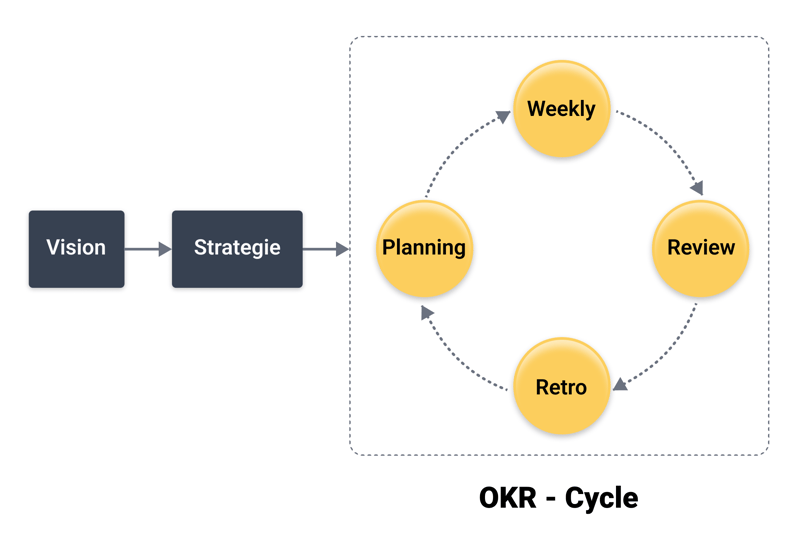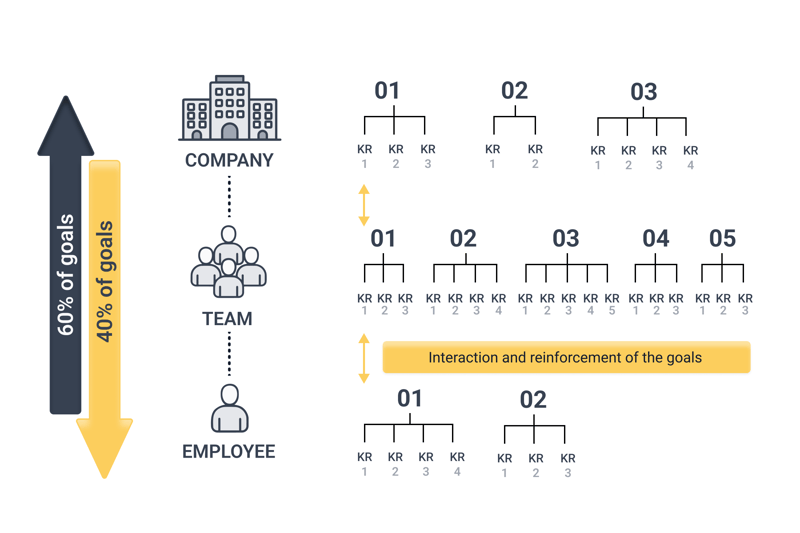What do Google, Intel, and Netflix have in common? They all use the OKR method. But what do these three letters mean, what's the method for, and which advantages does it offer?
Below, we'll answer all of these questions and more, sharing everything that you need to know about the OKR method, including how you can integrate it into your business's everyday routine.
What Is the OKR Method?
OKR is an agile management method that helps businesses to more effectively define and achieve their goals. It stands for objectives and key results. Let's take a brief look at its history and development:
Origin of the OKR Method
Intel co-founder Andrew S. Grove developed the OKR method in the 1970s, but it wasn't until 1999 that it became popular. This happened after John Doerr, an investor, brought it to Google:
While still at Google, one of its co-founders, Larry Page, had the following to say about the approach:
"OKRs have helped lead us to 10x growth, many times over"
From there, it didn't take long for the OKR method to spread throughout Silicon Valley. Nowadays, it's used by a seemingly endless number of businesses and organizations of all sizes and branches in their day-to-day operations.
Unlike Scrum, there's no institutionally agreed-upon OKR framework. This means that its implementation varies from business to business and depends on the consulting firm or expert. Some work with fixed pillars and principles that are meant to help with its application in practice. John Doerr summarized the basic underlying concept of the OKR method as:
I will accomplish 'X' (Objective) as measured by 'Y' (Key Result).
"Objectives" answer the question of what the OKR should accomplish, while the "key results" offer the how. Don't think of these as to-dos or specific activities, but rather, as descriptions of certain goal-setting aspects that need to be coordinated with one another.
What Are Objectives?
These are the goals and targets to be achieved or reached and have the following characteristics:
Ambitiously formulated (reach for the stars, i.e. "Moonshot")
Qualitative rather than quantitative and potentially abstract
Describe a desirable condition or state
Easily recognizable value
What Are Key Results?
Key results provide waypoints for how a goal can be reached and have the following characteristics:
Quantitative and measurable
Firm up the accompanying objective
Every objective has 2-5 key results
Formulated in a specific, ambitious, and goal-oriented way
Independent of one another
Does the last goal sound familiar? If so, that's because it is: The OKR method aligns in some aspects with the SMART goal-setting formula, however, it also takes things a step further.
Daniel Montgomery, the managing director of Agile Strategies, summarized the differences between the two. According to him, SMART provides a structure for goals and targets, whereas an organization's OKRs align and reinforce each other. As such, OKRs aid in goal management.
In addition to the well-known structural features from SMART, the OKR method also provides a complete, cyclical framework.
The OKR Cycle and Its 4 Phases
Businesses with long-term visions can only achieve their goals by following well-developed strategies. OKRs help to translate strategies into a series of objectives that can be measured in a step-by-step process.
In our fast-paced world, conditions and requirements constantly change. So, what should you do if the goal your business comprehensively defined and set last year isn't applicable to the environment's requirements when you reach it this year? The OKR method provides built-in flexibility, since its objectives are regularly evaluated and, if needed, adjusted:

Objectives are regularly evaluated and updated.
The cycle's length can be optimized to your business's needs, however, most organizations benefit from cycles that last 2-4 months. This means that a cycle is performed approximately every quarter, adding up to four per calendar year.
An OKR cycle has four components. If you have some Scrum experience, these steps should sound familiar to you. We'll briefly introduce and summarize them below:
Planning
During the planning phase, you'll specify the upcoming cycle's objectives and key results. Make sure that objectives are clearly communicated so that all teams and departments can internalize them. Should multiple teams be assigned to work on the same objectives, organize regular meetings. This helps to better coordinate goals with one another as well as align them to your corporate strategy.
The OKR method is rarely limited to a single team and instead impacts an entire business or organization. As such, every level, from management to individual employees, should formulate OKRs.
Broadly speaking, about 40% of the objectives should be put forth by management (top-down), while the remaining 60% should be bottom-up, from employees. At the same time, keep your business's needs in mind and be flexible: If employee-level OKRs don't make sense in your organization, focus on other levels.
Each level should specify 2-5 objectives and formulate 2-5 accompanying key results.
Note: Key results must be independent of one another and not influence each other.

Objectives should be formulated by the entire organization.
The result? All of the objectives that the business formulates impact its strategy and vision.
Weekly
After the planning phase, teams begin working on reaching the objectives defined in the previous stage. This makes the OKR's weekly similar to a Scrum daily. The main difference is that progress is not checked every day but in pre-defined intervals.
It is recommended to evaluate OKRs on a weekly basis, at the minimum.
Review
At the end of the cycle, during the review, teams present their results and grades. Just like in school, a grade reflects the extent to which a specific key result was achieved. Percentages (0-100) have become the preferred method of calculating this, and every team chooses a value for their key results.
A grade also shows whether the objectives set in the first stage were ambitious enough. Although a perfect grade might seem ideal, 100% actually indicates that the targets weren't challenging enough. According to experts and Google, the "sweet spot" is from 60-80%.
Sometimes, a traffic light system is used to visualize the extent to which objectives have been achieved:
Green: 70–100 % – The team achieved the specified objective.
Yellow: 40–60 % – The team missed the objective, but did make some progress.
Red: 0–30 % – The team cannot show any significant progress.
Retrospective
During the retrospective, insight from all of the preceding phases is summarized and discussed. As its name implies, this last step of the cycle is about evaluating what occurred earlier: The team reviews its efforts, how the OKRs were approached, as well as the methods that were used.
Some commonly asked questions during this phase include:
In which areas were we successful, and why?
Where did we get bogged down or set the wrong priorities?
What should we do differently next time? What should stay the same?
Once again, this phase demonstrates some similarities to a Scrum retrospective, and several aspects are applicable to both approaches.
Based on the retrospective's findings, the team can prepare for the next OKR. With that, the first cycle is finished, and the process can start over again. Results from the previous OKR cycle will flow into the upcoming cycle's planning stage and the team can adjust or modify its objectives accordingly.
Advantages and Disadvantages of the OKR Method
The OKR method can benefit businesses and organizations in a number of ways. At the same time, it's not without disadvantages.
Goal-oriented
The OKR method focuses on team and organizational objectives. This helps to better align it with the business's overall strategy.Better understanding
Teams and employees will gain greater awareness of their organizational roles.Measurable results
Results are concrete and measurable.Motivation boost
Ambitious objectives can enhance engagement and morale among teams and staff.Greater transparency
Since employees know what the business's goals are, the company becomes more transparent.Prevent stagnation
The risk of missing an objective is reduced.Flexibility
The OKR method can be flexibly adjusted to the needs and characteristics of any business or organization. OKRs can be adapted to nearly all projects or environments.
Potentially discouraging
Choose objectives carefully: Being either too complacent or too ambitious can sink your staff's morale.Labor intensive
Defining and achieving objectives takes a lot of time. Beyond that, you'll also need to devote energy and resources to monitoring progress.No template
Unlike the other agile project management methods, OKR doesn't have a standard framework.
The OKR Method in Practice
If you'd like to bring the OKR method to your business or organization, start by scheduling a workshop. Gather your top management and department heads, so that you can jointly develop a strategy and an initial understanding of what lies ahead.
After this, employees need to be introduced to the method and how to properly formulate OKRs. Only correctly formulated OKRs can help to achieve goals and targets.
Below, we've provided an example of a well-formulated OKR:
Example | Explanation | |
|---|---|---|
Objective | Our web presence impresses our customers. | The objective is abstract and describes an ideal state with a clear benefit. |
Key Results | KR 1: We increase the loading speed by 20%. KR 2: The number of monthly visitors to our website passes the 200,000 mark. | The key results are independent of one another, while also being ambitious and measurable. |
Would you like a few more examples, or to find out what separates good OKRs from bad ones? Be sure to check out our list of OKR examples.
Does your organization already have an OKR expert? If so, you can embark upon your first OKR cycle. However, in the event that you don't have an OKR pro close by, it's a good idea to get in touch with a consultant or agency, especially if you're planning to examine multiple departments or sections. Even though the method sounds straightforward, implementing it can prove tricky.
Implementation Success Factors
The OKR method can be adapted to any type of business. With that said, the factors below are almost always important:
Communication: In order to find a mutually agreeable way forward, you'll need clear and open communication. This includes regular coordination and feedback sessions with your employees, as well as involving them in the decision-making process.
Responsibility: All participants should feel responsible for contributing to the success of OKRs. It's advantageous for employees to be able to identify with their role(s). In addition, every team should have the chance to constructively contribute their own ideas.
Transparency: Everyone involved should have a clear understanding of the objectives and how they are to be achieved. Involve other teams in the OKRs, so that an exchange can develop.
Flexibility: Remember that OKRs aren't etched in stone. If conditions or requirements shift, go with the flow, and adjust your objectives in the next cycle.
Feedback: Giving and receiving regular feedback helps to recognize success or failure early on. Long-term success can only be guaranteed when an organization embraces a culture of learning and development.
Conclusion
Every business or organization has a goal. Even then, it's rarely easy to set objectives or targets and effectively pursue them. The OKR method offers an agile framework for businesses to focus on their goals and measure progress towards them.
For this to be effective, it's important that the conditions are right: Transparency, open channels of communication, and flexibility are just a few of the most essential success factors. Anyone who wants to follow Google's recipe for success can start planning their first OKR cycle, or get in touch with external consultants and experts.
FAQs
OKR is a goal-setting method and management approach that stands for "Objectives and Key Results". With it, businesses and organizations can define and set long-term goals, while evaluating their progress in short and agile cycles.
Large and small organizations can utilize the OKR method. The framework can be optimized to the needs of just about any branch or type of business, from HR to project management.
For the method to work in practice, transparency, open communication, responsibility, flexibility, and a healthy feedback culture are important. A business that wants to use the method should make sure that it possesses all of these characteristics before starting its first OKR cycle.






